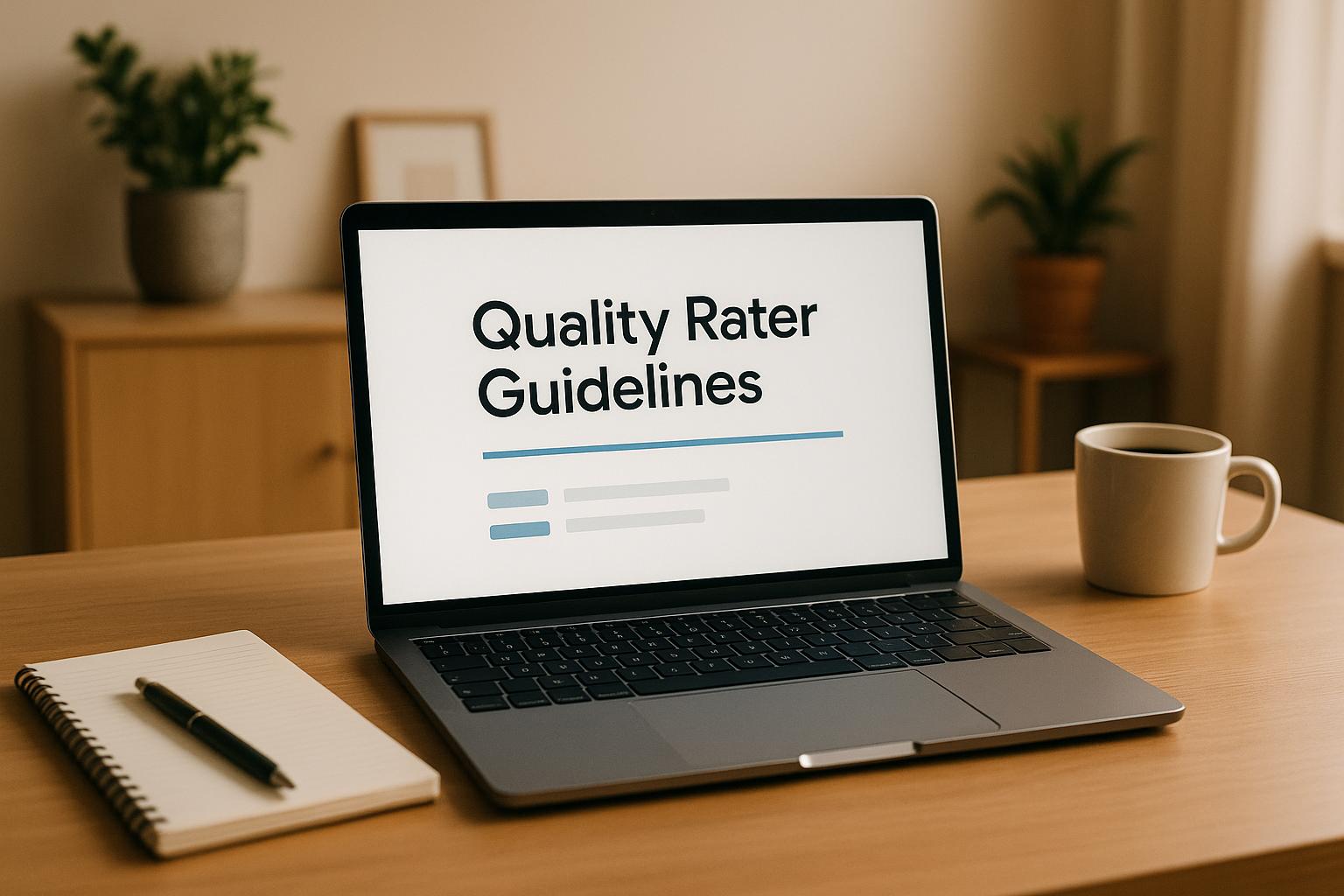Google’s Quality Rater Guidelines have undergone significant updates, impacting how content quality is judged for search rankings. The 2024 revisions focused on AI-generated content, user trust, and firsthand experience, while refining spam detection and user intent evaluation. Here’s what you need to know:
- AI Content Standards: AI-generated content is judged by the same quality benchmarks as human-written material, emphasizing originality, accuracy, and human oversight.
- EEAT Framework: Trust and firsthand experience are now central to content evaluation, particularly for sensitive topics like health and finance.
- Spam Detection: Stricter guidelines for identifying low-quality and harmful content.
- Modern Content Formats: Updated evaluation criteria for short-form videos and community-driven platforms.
These changes highlight the importance of creating content that prioritizes user needs, transparency, and relevance. SEO professionals must focus on producing high-quality material, whether human or AI-assisted, to maintain strong search rankings.
All of the Changes in the Quality Rater Guidelines Jan 2025 Update
Key Changes to Google’s Quality Rater Guidelines in 2024
In March 2024, Google introduced updates to its Quality Rater Guidelines, focusing on tackling spam and refining how user intent is understood.
Barry Schwartz, a Contributing Editor at Search Engine Land, highlighted the significance of these updates, saying:
"Although search quality evaluators’ ratings do not directly impact rankings, they do provide feedback that helps Google improve its algorithms. It is important to spend some time looking at what Google changed in this updated version of the document and compare that to the previous version of the document to see if we can learn more about Google’s intent on what websites and webpages Google prefers to rank. Google made those additions, edits, and deletions for a reason."
New Standards for Low and Lowest Page Quality
One major revision involved the "Page Quality Lowest and Low" sections. According to Google’s official change log:
"Updated Page Quality Lowest and Low sections to better align with Google Search Web Spam Policies; added illustrative examples"
This update places a stronger emphasis on identifying and addressing spam content. By including more detailed examples, Google aims to ensure quality raters can consistently spot pages that fail to meet its standards. For SEO professionals, this means prioritizing content that serves users genuinely and adheres to Google’s Web Spam Policies, rather than simply trying to rank higher on search results.
Enhanced Needs Met Rating System
Google also refined its "Needs Met" rating system to better evaluate user intent, especially for complex or ambiguous queries. The updated guidelines provide clearer instructions for handling searches with multiple possible meanings or goals. For instance, ambiguous queries like "apple" could refer to the fruit, the tech company, or recipes. Raters now have more precise methods to assess these searches, encouraging content creators to address a broader range of user needs. This shift pushes SEO professionals to craft content that caters to diverse intents, ensuring it resonates with a wider audience.
AI-Generated Content: Updated Rating Standards
Google’s 2024 Quality Rater Guidelines bring a fresh perspective to evaluating AI-generated content. These updates reflect the increasing role of artificial intelligence in content creation, setting clearer expectations for what qualifies as acceptable or problematic. Rather than making blanket judgments about AI-generated material, the focus is now on content quality and user experience, no matter how the content is created.
How AI Content Gets Rated
Under the updated guidelines, AI-generated content is held to the same standards as human-written material. Raters are tasked with evaluating it based on originality, user value, and whether it has been reviewed by a human.
For AI content to score highly, it must provide genuine value to users. Content produced solely to manipulate rankings – without offering anything meaningful – receives the lowest ratings. On the other hand, AI content that delivers unique insights, solves specific problems, or presents helpful information can rank very well.
Human oversight is key. The guidelines emphasize the importance of human involvement in the creation and refinement of AI content. High-quality AI material typically benefits from fact-checking, editorial review, and thoughtful editing. Content that skips this step often contains errors or lacks coherence, leading to lower ratings.
Another red flag for raters is mass-produced AI content. Text that feels generic, overly repetitive, or churned out on a large scale is rated poorly. This encourages creators to see AI as a tool to enhance their work, rather than a replacement for human creativity and expertise.
Quality Comparison: Human vs. AI Content
The updated guidelines include clear benchmarks to help raters identify high-quality content, whether created by humans or AI. Below is a comparison of key quality factors.
| Quality Factor | High-Quality Content | Low-Quality AI Content |
|---|---|---|
| Originality | Offers unique perspectives, fresh insights, or personal experience | Relies on generic information, repetitive phrasing, or templated structures |
| Accuracy | Uses fact-checked, reliable, and up-to-date sources | Contains outdated data, factual errors, or unsupported claims |
| User Value | Solves real problems and answers specific questions | Created primarily to rank in search engines, with little practical use |
| Human Oversight | Includes clear editorial review and refinement | Published without review, prone to errors |
| Depth | Provides comprehensive coverage and nuanced analysis | Offers surface-level information with little detail or exploration |
This comparison shows that content quality is determined by execution, not origin. Well-researched and carefully reviewed AI content can rival or even surpass poorly written human content. However, AI-generated material that lacks oversight or originality typically falls short of Google’s standards.
The guidelines also acknowledge that different types of content – whether technical, creative, or news-related – require tailored approaches when using AI. This ensures that AI serves as a complement to human effort, rather than a shortcut.
EEAT Framework: Trust and Experience Updates
Google’s 2024 updates have introduced an expansion to its EAT framework, now called EEAT, by placing a stronger emphasis on real-world experience alongside formal expertise. This change highlights that firsthand knowledge – like using a product, visiting a location, or living through a situation – can bring valuable insights, even if the person lacks formal qualifications. It’s a shift that acknowledges the diverse ways credibility can be established, depending on the topic.
For instance, Your Money or Your Life (YMYL) content now reflects this nuanced approach. A certified financial planner offering advice on investments holds a different kind of credibility than someone sharing their journey of paying off $50,000 in debt. Both perspectives can be meaningful, depending on what users are looking for.
Trust as the Main Content Evaluation Factor
At the heart of the EEAT framework is trust, which serves as the foundation for evaluating all other quality factors. The 2024 guidelines make it clear: trust is non-negotiable, especially for YMYL content. This includes areas like medical advice, financial guidance, legal information, and safety tips – topics where misinformation or errors can have serious consequences.
To build trust, content must demonstrate accountability, accuracy, and transparency. Here’s what that looks like:
- Author transparency: Articles should include clear bylines and credentials, making it easy for users to understand who wrote the content and why they’re qualified.
- Robust site structure: Websites publishing YMYL content need detailed "About Us" pages, accessible contact information, and evidence of editorial oversight.
- Factual accuracy: Proper citations, up-to-date information, and correction policies are essential. For example, a medical site citing outdated studies or a financial blog sharing incorrect tax data can severely damage trust.
- User safety: Content that could harm users – like unsafe DIY projects or unverified medical treatments – receives the lowest possible ratings, no matter how well-written or well-meaning it may be.
Experience vs. Expertise: When to Use Each
The updated guidelines make it clear that experience and expertise play different roles, depending on the type of content and the audience’s needs.
- Experience is most valuable for content like product reviews, travel guides, lifestyle articles, and personal finance stories. For example, someone who has spent months testing running shoes can provide insights that are different – but equally valuable – compared to a podiatrist discussing biomechanics.
- Expertise, on the other hand, is critical for technical subjects, professional advice, and specialized knowledge areas. A tax software review, for instance, benefits from an accountant’s expertise about compliance, while a casual user may focus more on ease of use.
The table below outlines how experience and expertise balance out across different content types:
| Content Type | Experience Priority | Expertise Priority | Ideal Combination |
|---|---|---|---|
| Medical Treatment | Patient stories, side effects | Clinical knowledge, research | Doctor-reviewed patient testimonials |
| Financial Planning | Personal success stories | Professional credentials | CFP sharing client case studies |
| Product Reviews | Long-term usage, real scenarios | Technical specifications | Engineer testing consumer products |
| Travel Content | Personal visits, local insights | Cultural knowledge, history | Local guide with tourism certification |
| Legal Advice | Court experience outcomes | Bar certification, case law | Attorney with relevant practice area |
The best content often blends both elements. For example, a dermatologist who also struggles with acne brings not only professional knowledge but also relatable, personal experience. This combination resonates with users while maintaining credibility.
YMYL subcategories also vary in how they balance experience and expertise. For shopping or commercial content, firsthand usage and purchase patterns often outweigh theoretical knowledge. On the other hand, news and current events demand journalistic expertise and editorial rigor, though firsthand reporting adds depth.
Content creators should tailor their approach to the topic. For example, restaurant reviews benefit from multiple dining experiences rather than culinary school credentials. Meanwhile, investment advice requires professional expertise, market experience, and proper licensing. Transparency about both experience and qualifications is key – it helps both users and quality raters evaluate content more effectively.
sbb-itb-880d5b6
Minor Updates and Technical Changes
In addition to the major framework updates, Google’s Quality Rater Guidelines have undergone several smaller updates to align with the rapid evolution of web technologies and content formats.
One notable change in the January 23, 2025 update was the adjustment of technical requirements for quality raters. This included updated browser specifications to ensure compatibility with modern web standards, allowing raters to work more effectively with contemporary tools and platforms. These technical tweaks set the stage for further improvements in content evaluation.
Google also took steps to modernize the guidelines by removing outdated examples. References to older technologies and irrelevant content formats were eliminated, making the guidelines more streamlined and focused. This shift ensures that raters now have access to scenarios that reflect today’s digital landscape.
New examples introduced in the update highlight current trends, such as short-form videos ranging from 15 to 60 seconds, as well as content from community-driven forums. These additions help raters assess the quality of popular formats seen on platforms like TikTok, Instagram Reels, and YouTube Shorts, while still valuing the role of forums in fostering user engagement.
Other refinements, such as minor adjustments to rating ranges, typo corrections, and clearer language, enhance the overall readability and precision of the guidelines.
For SEO professionals, these updates are a reminder to stay aligned with modern web standards and emerging content trends. By focusing on updated formats and technical requirements, Google signals a shift toward better evaluation of today’s digital content. Adapting strategies to these changes is crucial for maintaining compliance and staying competitive in an ever-evolving online environment.
Key Takeaways for SEO Professionals in 2025
Google’s 2024 updates to its Quality Rater Guidelines bring a notable shift in how content is evaluated, with trust becoming the central pillar of quality assessments. For SEO professionals, this means placing a strong emphasis on credibility by focusing on transparent authorship, clear sourcing, and showcasing expertise throughout their content.
Under the updated guidelines, all types of content are evaluated with the same level of scrutiny. AI-generated content isn’t automatically penalized, but it must meet the same high standards as human-authored material. The key lies in execution – AI-generated content that lacks depth, accuracy, or meaningful value will fall short. Instead, professionals should view AI as a tool to complement human expertise, not as a replacement.
The guidelines also underscore the importance of balancing experience and expertise in content creation. In many cases, authentic, firsthand experience is weighted more heavily than formal credentials. This is particularly relevant for areas like health advice, product reviews, and lifestyle content, where personal insights and real-world experience can significantly enhance credibility.
Another critical update involves stricter evaluations for low-quality content. Pages that are thin, misleading, or potentially harmful are now more likely to receive the "Lowest" quality rating. This shift could influence how search algorithms rank similar content, making it essential for SEO professionals to avoid such pitfalls.
Beyond content principles, technical standards have also advanced. The guidelines now emphasize modern web formats, including short-form videos and community-driven discussions, alongside traditional SEO fundamentals. Adapting strategies to incorporate these newer formats, while maintaining high-quality standards, is crucial for staying competitive.
To align with these updates, actionable steps for SEO professionals include auditing trust signals, updating author bios with relevant credentials, ensuring transparent sourcing, and thoroughly reviewing AI-assisted content for accuracy and value. Regularly evaluating content against evolving digital trends while adhering to Google’s quality benchmarks will help maintain compliance and gain a competitive edge in search rankings.
FAQs
How do Google’s latest Quality Rater Guidelines address AI-generated content compared to human-written content?
The 2024 and 2025 Updates to Google’s Quality Rater Guidelines
Google’s latest updates to its Quality Rater Guidelines for 2024 and 2025 place a spotlight on AI-generated content. The key takeaway? It’s not about whether content is created by humans or AI – it’s about its quality, originality, and how well it aligns with Google’s E-E-A-T principles: Expertise, Experience, Authority, and Trust.
If AI-generated content is thoughtfully crafted, genuinely useful, and meets the user’s intent, it can perform just as well in rankings as human-written content.
On the flip side, content that’s poorly written, crammed with keywords, or lacks originality will likely be flagged as low quality. This can harm search rankings. The bottom line is clear: whether created by a person or a machine, content must be helpful, relevant, and trustworthy to succeed.
What is the EEAT framework, and how does it impact content about sensitive topics like health and finance?
The EEAT framework – standing for Experience, Expertise, Authoritativeness, and Trustworthiness – plays a crucial role in how Google judges content quality. This framework becomes especially important for Your Money or Your Life (YMYL) topics, like health and finance, where precision and dependability are non-negotiable.
To align with EEAT, content creators should showcase firsthand experience, emphasize relevant professional qualifications, and ensure that the information presented is reliable. For sensitive subjects, this could mean including thorough author bios, verified credentials, or even expert reviews. Following these principles helps build credibility and increases the likelihood of ranking higher in search results.
How do Google’s updated spam detection guidelines impact SEO strategies in 2025?
Google’s Updated Spam Detection Guidelines for 2025
Google’s latest spam detection guidelines for 2025 put the spotlight on creating genuine, high-quality content that truly serves users’ needs. This shift encourages SEO professionals to prioritize helpful, user-focused information while steering clear of manipulative tactics like keyword stuffing or spammy link schemes.
With these stricter rules, unethical practices can result in serious consequences, such as significant drops in search rankings. To remain competitive, it’s essential to embrace ethical SEO strategies. This means focusing on content that provides real value, improving technical aspects of your site, and enhancing the overall user experience.




